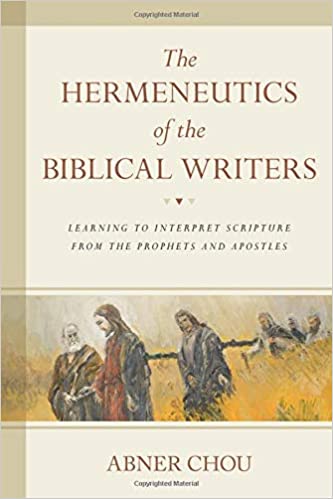A Brief Book Summary from Books At a Glance
By Steve West
About the Author
Abner Chou is the John F. MacArthur Endowed Fellow at The Master’s University in Santa Clarita, California. He is the author of numerous articles, a commentary on Lamentations, and I Saw the Lord: A Biblical Theology of Vision.
Introduction
In this book, Chou examines the method and logic by which the biblical authors read and wrote Scripture. He argues that the apostles followed the same rich hermeneutical method of the prophets, and that believers today should imitate this type of reading. Chou works through some difficult passages to demonstrate that the NT writers paid careful attention to the context of the OT authors, and as a result, they used the OT correctly. This book demonstrates that the Bible is a richly intertextual work, and that understanding both the small details and the big picture is essential for proper interpretation.
Table of Contents
Chapter 1 The Quest for Authorial Logic
Chapter 2 Groundwork for the Quest: Presuppositions and Method
Chapter 3 The Prophetic Hermeneutic: The Prophet as Exegete and Theologian
Chapter 4 The Prophet Hermeneutic: Did the Prophets Speak Better than They Knew, or Better than We Give Them Credit For?
Chapter 5 The Apostolic Hermeneutic: Continuity with the Prophets
Chapter 6 The Apostolic Hermeneutic: The Theological Fabric of the New Testament
Chapter 7 The Christian Hermeneutic: Reading as They Read and Intended
Chapter 8 Scripture’s Sophistication, First Theologians, and the Hermeneutics of Surrender
Summary
Chapter 1: The Quest for Authorial Logic
Hermeneutics is not merely an academic subject—it is essential for all of us to interpret Scripture accurately. Many are familiar with the literal-grammatical-historical interpretation where we seek to know what the authors meant by their words. Philosophical hermeneutics depends on our theology (e.g. our response to postmodernism depends on our understanding of Scripture). When we see how the Bible self-references, we can see that the Bible itself reveals a proper hermeneutical method. Complications seem to arise, however, when we look at how the NT authors use the OT. Some have argued that we cannot use the same hermeneutical approach that the NT authors used; they must have had special inspiration.
Others insist we must be able to follow them and use their methodology, or we are reading the Bible differently than they did. The issues cross disciplines, intersecting systematics, biblical theology, literary interpretation, and more. We need to try to determine how the NT authors thought about, understood, and used the OT in a redemptive-historical way. Looking for the author’s rationale in method and reasoning is the quest for authorial logic. Since the apostles used the OT, it is vital to study the OT itself. NT authors do not merely quote verses, they quote verses to evoke whole contexts and patterns. OT prophets had already thought through antecedent revelation, and they also evoked patterns and contexts—in many respects, the NT writers follow this previous approach. This hermeneutic of the prophets is key for what follows. “The prophetic hermeneutic continues into the apostolic hermeneutic, which is the Christian hermeneutic.” The NT authors use the OT contextually.
Chapter 2: Groundwork for the Quest
Presuppositions are crucial when it comes to hermeneutics, as well as for evaluating the hermeneutics of Jesus and the NT authors. Authorial intent is key in evangelical and biblical hermeneutics. Postmodern theorists argue that authors have no control over the meaning of their text, and even if they did interpreters could never know it; we can only know what we bring to the text. The Bible reveals that it is the Word of God, and that God’s intention can be known. Readers can distort textual meaning, so we need prayer and the Spirit’s guidance. We need to be careful about accepting a particular model (like typology) and then squeezing all NT use of the OT into that one approach. We want to see the implications of a text, and to do this we need to understand what the author meant. Significance cannot be detached from meaning. “Meaning” refers to the original author’s ideas, whereas “significance” deals with its application and ramifications.
NT authors can use the OT in a way that shows its significance, not just its meaning. It is important to understand, however, that accurately using the significance of the text requires understanding its meaning. There may be multiple ways that the text can be significant. Scripture is interconnected; there is real intertextuality. It is not merely a matter of reading the NT and looking up the OT quote: there is a rich allusion that brings together whole interpretive contexts which establish the author’s logic. Texts are woven together in the OT already, and NT authors draw on this interweaving and also add additional texts together. Authors leave linguistic clues that they are working with intertexuality; these clues are intentional. We must go further to identify all the relevant texts and also see how they were connected. Jesus’ use of Exodus 3:6 illustrates a move to significance, as well as bringing together an entire theological point from the Pentateuch.
[To continue reading this summary, please see below....]The remainder of this article is premium content. Become a member to continue reading.
Already have an account? Sign In
